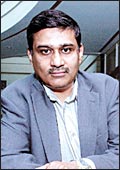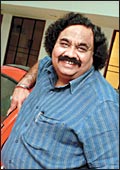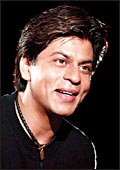 |
| Moser Baer's Puri: Spotting
solar energy |
Ratul
Puri, executive director, Moser Baer, the world's second largest
manufacturer of optical media, is excited. Puri expects margins
in the optical disc business to be a chunky 35 per cent in the
coming quarters. But that's not the reason for the excitement.
Rather, it's a little-known subsidiary of Moser Baer that's responsible
for Puri's upbeat mood.
Moser Baer Photovoltaic (MBPV) started out
in 2003 and the parent company has invested close to Rs 350 crore
in this company. Photovoltaic technology is the ability to take
photons from light and convert them to energy-as in solar cells
for most people. But Puri isn't thinking calculators and watches.
"If I were to cover the roof of this office with solar energy
sources, I could easily offset a significant amount of my electricity
bill," he says.
But Photovoltaic technology has been around
for over a century, and other than a few niche applications in
small gadgets and satellites, it has always been considered too
expensive. Puri expects MBPV to change the paradigm. "In
the mid-90s, it cost around $1.50 to generate one unit of energy
(1 Kilowatt Hour) from solar cells. Thanks to some aggressive
development in Japan over the last decade, generation costs in
2005 had come down to around 40-50 cents per unit. With further
development, including some of the development being done by our
scientists, we believe that these costs can come down further
in the coming years," he says.
Puri knows exactly what he is talking about;
solar energy is already becoming extremely popular in environmentally
conscious countries such as Germany. "There are two major
reasons, and none of them is tax breaks," Puri laughs. Reason
#1: Solar energy is what he describes as "peaking energy.
Energy consumption peaks at the middle of the day, and solar cells
are most effective at the middle of the day," he explains.
The second reason is that "traditional energy requires large
plants to produce it efficiently-places known as 'well-heads'-yet
transmission and distribution losses are massive even in the best
of places by the time it gets to your socket. Photovoltaic energy
is a 'socket-head', it is on the roof of your house," he
adds.
A significant amount of the investment that
MBPV has made has been in acquiring stakes in small solar-energy
start-ups in an attempt to enhance its intellectual property portfolio.
Puri says the three companies (Solaria, SolFocus and Stion, all
us-based) are doing some pathbreaking work in photovoltaic technology
and they make a good fit for MBPV.
Yet, as Puri himself points out, solar energy
hasn't taken off because mass production of solar cells has been
a problem. MBPV's manufacturing plant will begin mass production
by the first quarter of 2007-08, after which Puri expects costs
of solar cells to further fall. Last year, the global photovoltaic
industry was worth $6 billion (Rs 27,000 crore), and an advocacy
group says that by 2010 the market will be worth $40 billion (Rs
1,80,000 crore).
"Do you know who one of the richest
men in China is today?," asks Puri. The man in question is
Shi Zhengrong (Seventh on Forbes' list of China's richest people
with an estimated net worth of $1.43 billion or Rs 6,435 crore),
who started the Wuxi-based Suntech, a giant in solar energy.
-Kushan Mitra
Go
Forth and Multiply
Ad agencies are pitching for conflicting
clients and how.
 |
 |
 |
| (L to R) JWT's Harris, O&M's
Pandey and Dentsu's Goyal: Now, multiple agencies is the
mantra |
First
there was Ogilvy & Mather (O&M). Then came David. And
now you have Meridian and Dakshin. Welcome to the intriguing universe
of multiple advertising agencies, where a second agency doesn't
raise eyebrows and, these days, neither does a third or even speculation
of a fourth. Time once was when JWT (then HTA) set the trend of
a subsidiary agency by flagging off Contract Advertising in 1986.
Today, Contract itself is an agency to reckon with, figuring in
the country's Top 15. JWT has now transformed Fortune, a financial
services advertising arm, into a full-service agency. "It's
a mainstream agency today," avers JWT CEO Colvyn Harris.
"From a client's perspective, Fortune offers the credibility
of a large agency and the nimbleness of a small agency,"
says Suranjan Das, Senior Vice President & Managing Partner,
Fortune, which has a client base that includes Toshiba home appliances,
Casio watches, Tech Mahindra and Chateau Indage.
The main reason for setting up another (or
yet another) agency hasn't changed over the years: To be able
to pitch for conflicting clients within the same product category.
At a time when there is buoyancy in the economy and the advertising
industry is registering robust growth (estimated at 13 per cent
for 2006), agencies don't want to lose out because of a conflicting
client clause. For instance, Dentsu's India operations comprise
two agencies, Dentsu Communications and Dentsu Marcom, and in
January a third, Dentsu Creative Impact, will be launched. Dentsu
Communications handles the Toyota account and Dentsu Marcom is
the agency for Honda cars. "There is a huge amount of business
that can be tapped today. The way we see it, Dentsu Creative Impact
will be a creative boutique," says Sandeep Goyal, Chairman,
Dentsu India. The capitalised billings for Dentsu in India currently
stand at around Rs 550 crore and Goyal is keen that he is among
the top three players in five years.
But there are other provocations too. Take
the case of O&M, where Meridian, Dakshin and David are all
positioned differently. "We wanted to understand the nuances
of south India which is why Dakshin was created. Dakshin has already
done Fanta commercials in the South" says Piyush Pandey,
Executive Chairman and National Creative Director, India &
South Asia, O&M. "David excels in on-ground activities;
Meridian is trying to handle b2b businesses and is currently doing
work for Dockers," adds Pandey.
JWT's Harris acknowledges multiple agencies
are influenced by "growth pressures," but that's not
the only reason for a second or a third unit. "They also
offer your people an avenue for growth," says Harris. JWT
is open to having another agency though Harris is tight-lipped.
"Yes, there are plans but these are at a development stage.
We should be able to talk about it during the first quarter of
next year," he says.
Yet, it's not as if subsidiaries are the
only growth avenue. Consider the case of Mudra, which has two
subsidiaries, Interact Vision and a more recent Canvas Communications.
Madhukar Kamath, Managing Director & CEO, sees a number of
possibilities for these agencies, and just one of them is a merger.
"They could grow to a point where they might have two distinct
identities or could be merged to form a large agency or they could
even be aligned with larger Mudra units," says Kamath. For
now, his priority is to make this Rs 1,000 crore communications
group hit the Rs 1,500 crore mark. Clearly there are multiple
routes to that goal.
-Krishna Gopalan
Hot
Seat Just Got Hotter
Can KBC III rake in the ratings like before?
 |
| Shah Rukh: Ready for small
screen |
The
new year will see the war for eyeballs in television hot up with
the return of Kaun Banega Crorepati (KBC). The third edition of
the show will not undergo a drastic change in format but will
have a new host in Shah Rukh Khan (Amitabh Bachchan anchored the
earlier two editions). "The new KBC will essentially be the
same except that Shah Rukh Khan will host the show. The prize
money of Rs 2 crore remains the same," says Sameer Nair,
CEO, Star Entertainment India. The programme will be on air from
Monday to Thursday at 9 p.m. on Star TV's flagship channel, Star
Plus.
And if history is any indicator, the show
is only likely to do better than its earlier editions. When first
launched in the 2000, KBC took Star Plus' channel share from 2
per cent to 25 per cent in the 9-10 pm slot, according to a special
study by tam. On its comeback trail, in 2005, KBC2 catapulted
Star Plus' viewership from 10 per cent four weeks before the launch
of the show to 38 per cent. In addition, towns in Madhya Pradesh,
with a population of more than a million people, clocked TVRs
of 38. The Hindi speaking belt struck a TVR of 20. Such TRPs have
not been heard of since the days when DD's mythological serials
like Ramayan and Krishna ruled the TRP charts. In addition, viewers
also spent more time viewing the serial, according to tam. In
2005, the average viewer in the metros was watching the episode
for 35 minutes, up from 29 minutes in 2000.
The big difference, this time around of course,
is the host. The question on every couch potato's lip is: Will
Khan be as captivating as Bachchan? What's more, after a long
time, Star Plus is facing a threat in the prime time 9-10 p.m.
band from Zee TV. Once the ICC Cricket World Cup begins in February
2007, for which Sony has the rights, television viewership is
expected to get further fragmented. Nair, for his part, appears
to have it all worked out. "We are not concerned with the
Cricket World Cup. Anyhow, most of India's matches are happening
on weekends. We are really not concerned with what our competitors
are doing," he quips. Meanwhile, the channel has admitted
that it is talking to mobile service providers for brand endorsements
for the programme. Star Plus also says the new show will feature
the largest deployment of communication technology to ensure calls
through landlines and mobile phones viewers get a chance to squeeze
into the 'Hot Seat'. As for Shah Rukh Khan, it's a home coming
to television after nearly two decades. The actor is taking his
comeback to television seriously and has 'a training set up installed
at home' for the programme. Khan also says that he would "go
down on his knees" to have the earlier host of the programme,
Bachchan, on the Hot Seat. Only an India-Pakistan World Cup final
would be capable of matching a Khan-Bachchan combo on the viewership
front.
-T.V. Mahalingam
Fresh
Fuel for Reva
The car run on alternative fuel finds investors
to fund growth.
 |
| Reva: Top gear |
Twelve
years after conception and five years after launch, a mere 1,800
Reva cars have been sold till date. That hasn't fazed two global
investors, Draper Fisher Jurveston and Global Environment Fund,
which last fortnight pumped $20 million (almost Rs 90 crore) into
this joint venture between Bangalore's Maini Group and the California-based
AEV LLC. Reva Electric Car Co. (RECC), as the name suggests, makes
automobiles that run on batteries, and its recent investors appear
to be betting on the trend of alternative fuel vehicles (like
the hybrid Toyota Prius or General Motor's hydrogen fuel car).
Chetan Kumaar Maini, Deputy Chairman & CTO, RECC, says: "The
infusion of funds will help us to enhance our R&D activities
as well as expand our market presence." He refuses to state
what stake has been offloaded, but adds that "we are still
the majority owners".
The company has unveiled its nextGen model
to be launched commercially by end of 2007, called Revanxg. It
has better styling and a range of around 200 kilometres per charge.
"With the fund infusion, we can expand our capacity to 30,000
cars per annum. We will have an operational break even by selling
just 2,500 vehicles a year. Our aim is to become (operationally)
profitable by 2007-08," says Maini. The Reva recently received
a leg-up in the UK, with some 600 vehicles plying on London streets.
Maini is now targeting other countries like Greece, Cyprus and
Spain to increase exports. "While I agree that we will never
replace the mainstream automobile, the target is the city commuting
vehicle and this holds a lot of potential," claims Maini.
His investors would be hoping so.
-Venkatesha Babu
|










